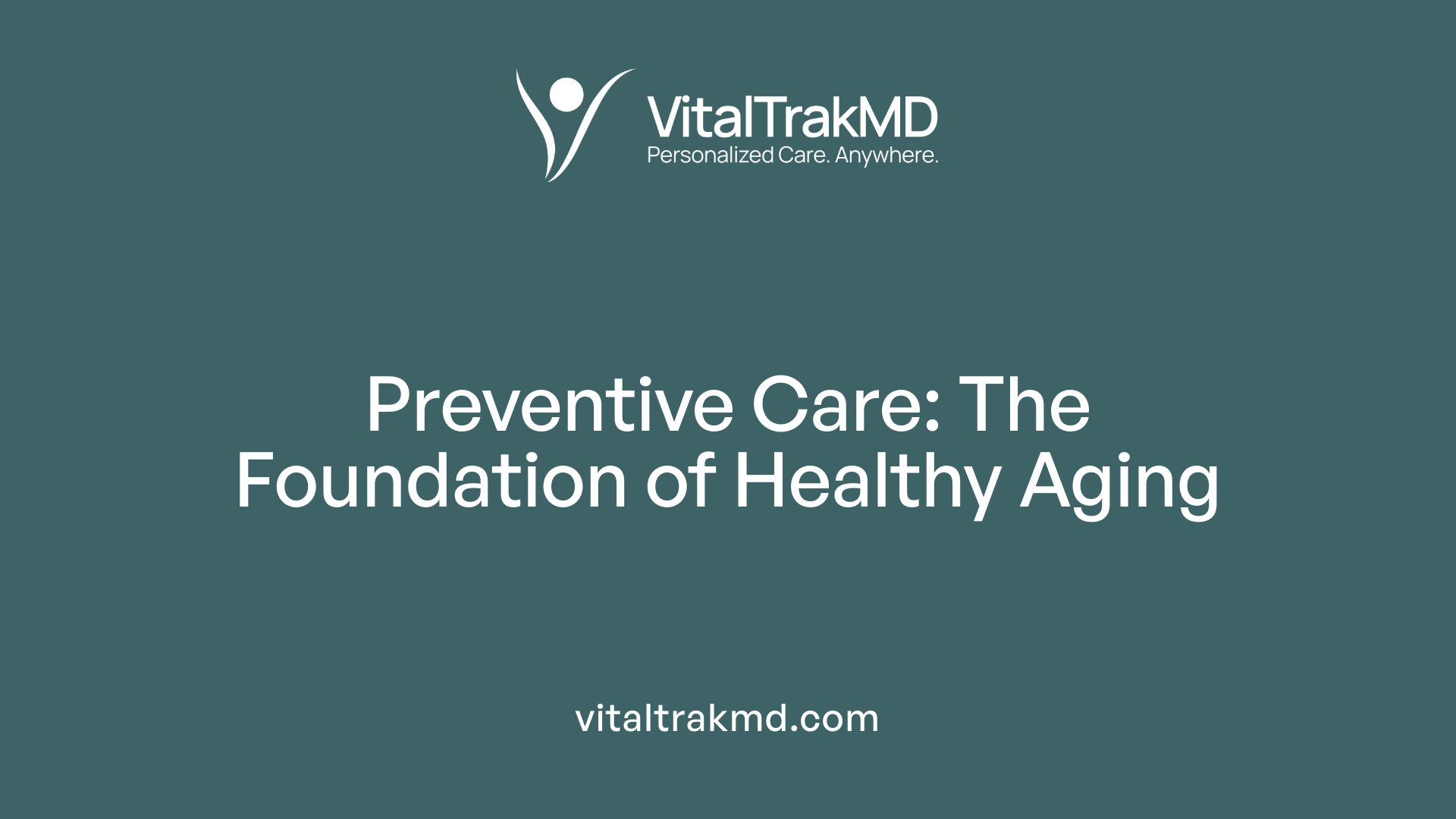Supporting Seniors With Education About the Benefits of Preventive Care

Understanding the Importance of Preventive Care for Seniors
As the population ages, promoting health and independence among seniors becomes increasingly vital. Preventive care offers a proactive approach that helps aging adults avoid or manage chronic conditions, reduces healthcare costs, and enhances their quality of life. This article explores the multifaceted benefits of preventive care for seniors, emphasizing the role of education, wellness programs, nutrition, behavioral strategies, and supportive care models in fostering long-term health and wellbeing.
The Critical Role of Preventive Care in Senior Health

What is preventive care and why is it important for seniors?
Preventive care aims to stop health issues before they begin rather than reacting after diseases develop. In seniors, this means regular screenings, vaccinations, and adopting healthy lifestyle habits that help detect or postpone chronic illnesses. By focusing on early intervention, preventive care improves quality of life and reduces the need for costly medical treatments.
Definition and goals of preventive care
Preventive care includes routine check-ups, immunizations, screenings for conditions like cancer, diabetes, heart disease, and osteoporosis, as well as education and counseling to encourage healthy behaviors. Its primary goal is to maintain health, manage risks, and prevent serious complications associated with aging.
Shift from reactive to proactive healthcare
This approach marks a transition from treating illnesses as they occur to actively maintaining wellness. For seniors, proactively managing health means lowering risks of falls, cognitive decline, and chronic disease progression through timely interventions and ongoing monitoring.
Common preventive health strategies for seniors
Seniors are encouraged to participate in annual wellness exams and receive vaccines such as influenza, pneumococcal, shingles, and COVID-19. Lifestyle strategies also play a vital role, including nutritious diet, regular physical activity, stress management, and social engagement. Mental health support through brain exercises and social connections further supports cognitive health.
Health outcomes and cost savings
Preventive care has proven benefits such as reducing cancer mortality by nearly 30% and lowering risks of heart disease, diabetes complications, and dementia. Economically, it decreases emergency visits and hospital stays, saving significant healthcare costs. Coverage mandates, like those in the Affordable Care Act, remove financial barriers to preventive services, increasing their use among seniors.
Regular preventive care empowers seniors to live healthier, more independent lives while easing the burden on healthcare systems through early detection and disease management.
Wellness Programs Tailored to Senior Preferences Enhance Engagement
Participation rates in wellness activities among seniors
Despite the clear benefits of wellness programs encouraging healthy behaviors and disease self-management, participation rates among older adults remain low. Less than 50% of seniors meet recommended physical activity guidelines, highlighting a significant gap in engagement with wellness initiatives.
Preferences by age and gender
Preferences for wellness activities vary notably by age and gender. Younger seniors, typically those aged 55 to 64, tend to favor internet-based programs and personalized one-on-one coaching sessions, often appreciating formats that include rewards. In contrast, older seniors generally prefer in-person group activities that foster social interaction. Women, in particular, exhibit a strong preference for group activities that promote social connections.
Formats favored: in-person group vs. internet-based coaching
While in-person group wellness programs appeal more to older seniors and women by providing community and social engagement, younger seniors lean towards flexible, technology-driven formats such as online coaching and interactive digital platforms. These differing preferences suggest that wellness programs must be versatile in delivery methods to cater effectively to various senior subgroups.
Association between healthy behaviors and activity interest
Interest in wellness activities is often linked to individuals’ current healthy behaviors. Seniors who already follow healthy diets or engage in physical activity show more enthusiasm for related wellness programs. This correlation indicates that cultivating early healthy habits may increase sustained wellness program participation.
Designing effective wellness programs for seniors
Creating wellness programs tailored to the distinct preferences of seniors—considering factors like age, gender, and existing behaviors—can significantly boost participation and outcomes. Programs that integrate healthy eating, purposeful living, physical activity, stress management, and social engagement within preferred delivery formats stand a better chance of keeping seniors engaged and improving their overall well-being.
Nutrition's Pivotal Role in Weight Management and Wellness for Seniors

What role does nutrition play in successful weight loss and wellness?
Nutrition is fundamental in achieving and maintaining weight loss, as well as in supporting overall wellness in seniors. It fuels the body with essential nutrients that aid metabolic functions and hormonal balance, which are critical in managing body weight and preserving muscle mass during aging.
Beneficial dietary patterns, such as the Mediterranean and Dietary Approaches to Stop Hypertension (DASH) diets, have demonstrated positive impacts on heart health and gut microbiota balance. These diets focus on healthy fats, lean proteins, whole grains, fruits, and vegetables, contributing to reduced inflammation and improved cardiovascular outcomes.
Nutrient quality and fiber intake
Emphasizing the quality of nutrients and increasing fiber intake play key roles in appetite regulation and digestive health. High-fiber foods help maintain fullness, prevent nutrient deficiencies, and support a healthy microbiome, which is vital for gut and immune system function.
Nutrition's link to mental well-being and immune function
Nutrition also directly influences mental health and immune response. Nutrient-dense diets rich in vitamins, minerals, and antioxidants support cognitive function, promote better sleep quality, and enhance resistance to illnesses.
Individualized balanced nutrition combined with physical activity
Adopting an individualized, balanced nutrition plan tailored to seniors' unique metabolic needs and combined with regular physical activity ensures sustainable weight management. This holistic approach helps improve quality of life by maintaining mobility, mental sharpness, and emotional well-being.
Effective Wellness Programs Integrate Education, Activity, and Behavioral Support

What are the most effective wellness programs for weight loss?
The most effective wellness programs for weight loss are those that combine several crucial components to create sustainable lifestyle changes. These include nutrition education, regular physical activity, and behavioral therapy. Experts recommend aiming for at least 150 minutes of physical activity per week, tailored to the abilities and preferences of participants.
Programs often focus on setting realistic weight loss goals, such as losing 5-10% of body weight within six months. Achieving these targets provides motivation and a measurable sense of progress, which encourages ongoing participation.
Ongoing support plays a vital role in success. Coaching—either one-on-one or in groups—and social networks provide accountability and encouragement, helping individuals maintain healthy habits over time.
Clinical evidence supports these approaches. For example, the Look AHEAD (Action for Health in Diabetes) study showed that structured lifestyle interventions significantly improved weight and related health outcomes, such as blood sugar control and cardiovascular risk.
Participants should be cautious of programs making unrealistic claims or promising rapid weight loss without a foundation in science. Verifying credentials of staff and ensuring program safety and efficacy are essential steps in selecting an appropriate wellness program.
These best practices ensure that weight loss efforts are both effective and safe, particularly important for aging adults who may have unique health considerations.
Behavioral Changes Essential to Successful Weight Loss and Maintenance

What behavioral changes are recommended for achieving and maintaining weight loss?
Achieving and maintaining weight loss requires adopting a variety of behavioral strategies. Mindful eating is fundamental; this means becoming more aware of hunger and fullness cues and controlling environmental triggers that may lead to overeating. For example, keeping tempting snacks out of sight can help reduce impulsive eating.
Meal planning and portion control are also crucial. Planning meals ahead encourages balanced nutrition and reduces spontaneous, unhealthy choices. Using smaller plates and emphasizing vegetables can help regulate portion sizes without feeling deprived.
Regular physical activity significantly supports weight management. Activities like walking and taking stairs increase calorie expenditure and improve overall health, especially when tailored for aging adults.
Self-monitoring techniques such as keeping food and activity journals foster accountability and highlight patterns needing adjustment. Cognitive-behavioral methods can assist in overcoming negative thought patterns and managing stress, which often undermine weight loss efforts.
Setting realistic, health-focused goals encourages steady progress and helps prevent discouragement. Managing stress effectively through relaxation techniques and social connections enhances adherence to healthy habits.
Finally, creating a supportive home and social environment is vital. Supportive family members and friends can encourage healthy eating and activity, while a home environment organized for success makes healthy choices easier.
These behavioral approaches, when combined, promote sustainable weight loss and improve overall well-being in aging adults.
Care Programs Supporting Long-Term Wellness and Weight Management in Seniors

How do care programs support long-term wellness and weight management?
Care programs for seniors are designed to promote long-term wellness by providing personalized coaching and nutrition counseling. These tailored supports help individuals develop and maintain healthy habits that lead to gradual, sustainable lifestyle changes rather than quick fixes. The focus is on manageable steps that encourage steady weight loss and overall improvement in quality of life.
In addition to nutrition advice, effective care programs incorporate physical activity, stress management, and social support to address both physical and psychological needs. This holistic approach helps seniors remain engaged and motivated while improving fitness, mental health, and community connection.
Several validated programs highlight the benefits of this model. For example, Dr. Dean Ornish’s Program has been scientifically proven to reverse the progression of heart disease through comprehensive lifestyle changes, including a healthy diet, exercise, and stress reduction techniques. Such programs not only stabilize health but also reduce the risk of chronic illnesses like diabetes and heart disease.
By blending personalized guidance with multiple wellness components, these care programs help seniors achieve lasting health improvements and better manage weight in ways that fit their individual preferences and conditions.
Technology and Community Initiatives Empower Seniors in Preventive Care
Telehealth and Virtual Healthcare Platforms
Telehealth has revolutionized access to preventive care for seniors by offering convenient 24/7 virtual consultations. Platforms like CareFirst's CloseKnit connect older adults with healthcare professionals for screenings, immunizations, and chronic disease management without frequent clinic visits. This innovation especially benefits those in rural or underserved areas by overcoming geographic barriers.
Wearables, Health Apps, and Home Safety Technologies
Wearable devices and mobile health apps provide seniors with real-time monitoring of vital signs and activity levels, promoting early detection of health changes. Additionally, fall detection systems and smart home devices enhance safety at home, reducing injury risks and enabling quicker emergency responses. Genetic testing technologies are also becoming part of preventive strategies for personalized health planning.
Community Health Fairs and Education Campaigns
Local community events serve as vital hubs for preventive care outreach by offering free vaccines, health screenings, and educational resources. These initiatives play a crucial role in raising awareness among seniors about healthy behaviors, immunizations, and screening importance, thereby bridging gaps in knowledge and encouraging participation.
Insurance Coverage Facilitation Through ACA and Medicare
The Affordable Care Act (ACA) and Medicare have made preventive care financially accessible by requiring health plans to cover recommended screenings and immunizations without copayments or deductibles. Medicare Advantage plans often bundle additional wellness benefits like gym memberships and nutrition counseling, enhancing seniors’ ability to engage in comprehensive preventive care.
Addressing Barriers: Accessibility, Affordability, and Awareness
Despite advances, barriers such as transportation limitations, costs, and lack of awareness still impede senior engagement in preventive care. Solutions include telehealth options, community programs, insurance policy reforms, and targeted educational campaigns. By focusing on these areas, health systems aim to improve utilization and health outcomes among aging populations.
Holistic Preventive Care: Physical, Mental, and Social Dimensions for Seniors
How Does Physical Activity Benefit Seniors?
Regular physical activity is a cornerstone of wellness programs for older adults. Exercise helps lower blood pressure, control blood sugar, reduce cholesterol levels, and improve blood flow to the brain. These benefits contribute to reducing the risk of chronic diseases like diabetes, heart disease, and dementia. Physical activity for seniors is often tailored to improve balance, strength, range of motion, and overall mobility, fostering greater independence and safety.
What Mental Health Strategies Support Aging Wellness?
Mental wellness is equally vital in preventive care for seniors. Activities such as meditation and brain exercises promote cognitive health and can delay decline. Social engagement also plays a critical role in mental health, helping reduce isolation and feelings of depression. Incorporating group activities like computer seminars, language lessons, and book clubs further stimulates cognitive function and emotional well-being.
How Do Social Activities Impact Older Adults?
Social activities included in wellness programs provide essential community connections, which help prevent loneliness and depression. Women, in particular, prefer group activities that enhance social interaction. These programs create supportive environments where seniors can share experiences and build friendships, contributing to holistic health.
Why Are Home Safety and Fall Prevention Important?
Home safety modifications form a vital part of holistic preventive care. Wellness programs often teach seniors how to reduce fall risks through environmental adjustments and provide education on fall prevention techniques. These measures contribute to seniors’ ability to live safely and independently.
What Access Do Seniors Have to Screening and Vaccination Services?
Preventive care includes comprehensive access to screenings for cancer, cholesterol, diabetes, blood pressure, and osteoporosis, along with vaccinations like influenza, pneumococcal, COVID-19, shingles, and hepatitis B. These services are essential to early detection and management of health conditions. Most insurance and Medicare plans cover these preventive measures, often at no out-of-pocket cost, making it easier for seniors to benefit from timely care.
The holistic approach to preventive care addresses the physical, mental, and social needs of seniors, promoting well-being, independence, and quality of life.
Empowering Seniors Through Comprehensive Preventive Care Education
Educating seniors about preventive care is essential to promoting healthier aging, reducing chronic disease burdens, and enhancing quality of life. Tailored wellness programs, balanced nutrition, effective behavioral strategies, and supportive care models are key pillars that enable sustained health improvements. Coupled with technological advances and community resources, these approaches help overcome traditional barriers to care. By fostering a culture of prevention through education and engagement, we can empower seniors to maintain independence, improve wellbeing, and reduce healthcare costs. Ongoing investment in personalized, accessible preventive services remains critical as the senior population grows.
References
- Aging Adults' Preferences for Wellness Program Activities ...
- Preventive Care for Seniors: How to Age Well and Stay ...
- Why Wellness Programs are Important for Seniors
- The Affordable Care Act's New Rules on Preventive Care
- Enhancing Access to Preventive Services in Underserved ...
- Importance Of Preventive Health In Senior Care
- Preventive Care For Seniors
- Understanding preventative care benefits: What to know in ...
- Wellvolution health and lifestyle programs
- Choosing a Safe & Successful Weight-loss Program - NIDDK
Recent articles
Want to Feel Better and Live Healthier?
Join hundreds of patients taking control of their health with personalized care that fits their life – not the other way around.
Rated 4.8/5 by 32+ customers







